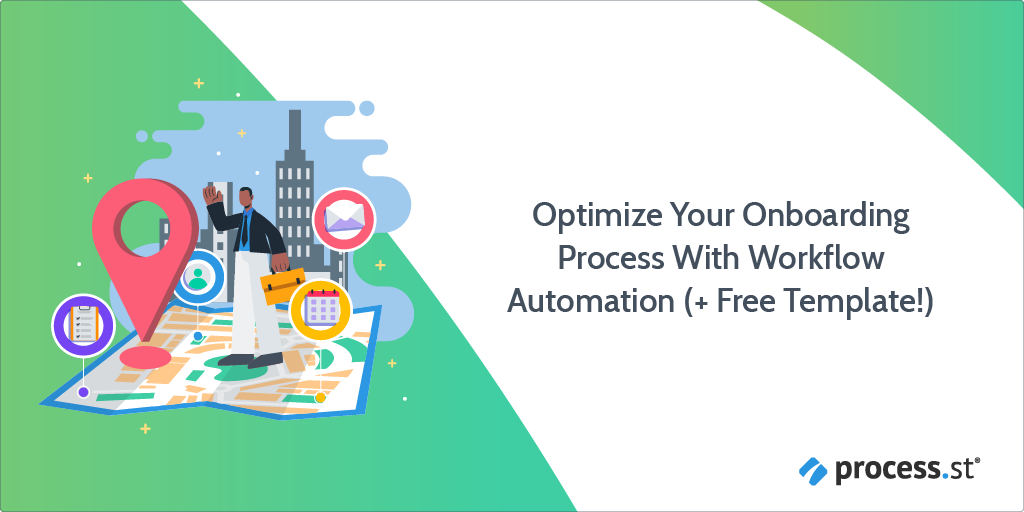 You’re an HR department of one (and a bit). You have a PEO (professional employer organization) for support, but basically, it’s just you handling the day-to-day.
You’re an HR department of one (and a bit). You have a PEO (professional employer organization) for support, but basically, it’s just you handling the day-to-day.
The CEO says he needs a new role filled ASAP with a list of qualifications. Filling the role will be a challenge, sure – but it’s not the main problem.
How are you going to get this new hire up-to-speed thoroughly in as short a time as possible when you don’t have any sort of standardized structure for doing that?
Simple: Build one.
Easy for me to say, right? It’s my job to build processes; I do it all the time. And that’s true. At Process Street, we do build processes all the time. Sometimes just for the heck of it. You might even say we’re pretty darn good at it.
This means – that’s right – we’ve already built the process you need. You can thank us later. Meanwhile, check out the rest of the post and exactly how you can optimize your onboarding so everyone has a good experience:
- A cautionary tale of one company’s onboarding woes
- Be the HR they need…
- Employee onboarding: Everything’s impossible until somebody does it
- For once, I’m stuck without a punchline
A cautionary tale of one company’s onboarding woes
Consider this:
Bruce and some of his colleagues decide to found a security firm together. It makes sense; they end up working together more often than not and they have a good dynamic.
After a few years and some major milestones, this company is the one everyone turns to in a crisis. Clients don’t even bother with public emergency services; they go straight to Bruce’s company. Things are good, but, as a result, Bruce is busier than ever and he needs a good right hand to look after the day-to-day operations.
Bruce hires Dick. It’s a little rocky at first. Dick is ambitious and eager to take on every new challenge, but he still has a lot to learn. Soon enough, though, they establish a routine and Dick becomes a cornerstone of the company, even creating and running a second branch.
Dick decides to strike out on his own. It’s fine – no hard feelings. These things happen. Bruce and Dick still even collaborate from time to time. But Bruce needs a new VP.

He hires Jason. Jason isn’t the obvious choice: he lacks experience, he’s a little impulsive, but Bruce thinks Jason will be a solid asset with some mentorship and guidance. After all, Dick worked out in the end.
It does not work out. Jason ends up leaving the company under pretty dramatic circumstances, joins a competitor, and shares some vital proprietary information. It’s a whole thing.
Bruce is off the whole idea of hiring a replacement now. He’ll just do it himself because then he knows it’ll be done correctly. But his co-founders are concerned. He’s working non-stop and it’s only a matter of time before he gets utterly burnt out or has a breakdown or something.
There’s a new freelancer making some waves. She’s self-taught but has a good head on her shoulders and the rest of the company’s leadership are pretty insistent about recruiting her.
After the interview, Bruce has to agree. Kate is focused, determined, and innovative. He could even see her taking over as CEO – one day. Not soon, but maybe at some point in the very distant future.
So he hires her, but now Bruce has a dilemma. He doesn’t want to make the same mistakes he made with Dick, and he certainly doesn’t want to repeat the whole Jason ordeal.
Bruce needs an onboarding process.
[Disclaimer: Any resemblance to fictional characters from an immensely popular entertainment franchise is absolutely intentional.]
Be the HR they need…
In the early days of a startup, a loose, ad hoc training structure is fine. The team is small. There aren’t a lot of set processes yet. Everyone is still figuring out how it’s all going to work as a cohesive unit.
As a company scales, however, this approach just isn’t good enough.
Going back to the example of Bruce, the biggest problem with his protégés was the inconsistency in their individual training. Dick learned things Jason didn’t, and vice versa; learning skills the moment they’re needed isn’t really an effective way to learn those skills. Or at least be able to perform them well.
Employees who haven’t been primed to complete a task, and then get reprimanded for not performing that task well, get frustrated. Frustration leads to resentment which leads to churn and churn is bad.
You wouldn’t trash a $60,000 piece of software because you left out some vital code; if you don’t provide your new hires with a good foundation, that is exactly what you’re doing.
With me so far?
[Disclaimer: The investment in a new hire isn’t just about salary. Most new hires take at least 6 months to reach 100% productivity, plus training materials, plus the time of the new hire, manager, and anyone involved in training and the lost productivity as a result of doing training sessions rather than their normal tasks and responsibilities.]
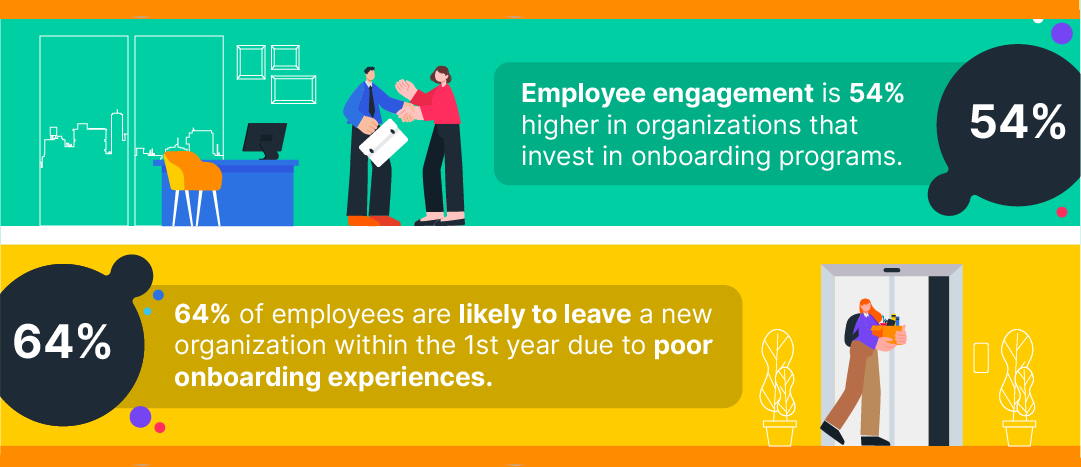 Don’t worry. This problem is totally fixable. Here are some quick tips:
Don’t worry. This problem is totally fixable. Here are some quick tips:
The first day shouldn’t be the First Day
Onboarding should start before your new employee ever walks in the door. Typically, this is referred to as “pre-onboarding,” but what you call it doesn’t really matter. The important thing to keep in mind is that this is your prep time.
HR-Do List:
- Welcome the employee to the company
- Ensure necessary paperwork is filled out & filed (DocuSign anyone?)
- Provide employee handbook (Pages is awesome for this)
- Notify team/department/company of new hire & encourage them to say hello (Slack all the way!)
- Make sure space (physical or digital) is set up for them (logins, desks, apps, etc.)
Consistency & standardization
The biggest complaint employees have about the onboarding process is its lack of consistency. Different trainers and/or managers have different approaches, different priorities, and different methods.
This results in a workforce that doesn’t have a consistent way of performing tasks and generally ends up with inconsistent results, confusion, and frustration on the part of both employee and manager.
Standardizing your onboarding process means everyone gets the same experience, regardless of who is running the process. This is cool for a few reasons:
- If someone is sick, unavailable, or no longer with the company, anyone else can step in and fill their shoes.
- Line managers can be confident of their team’s knowledge and abilities because everyone’s learned the same thing.
- New employees feel confident in taking initiative and ownership of their tasks because they’re fully prepared to handle any situation.
Transparency & honesty
From day one (or pre-day one), you need to keep your new hire in the loop. Walk them through the onboarding process so they have a roadmap of what they’ll be doing, how long it will take, and what the desired outcome is.
The roadmap guarantees the employee doesn’t have to worry about surprises. They can monitor their own progress to see how they’re doing or if they’re falling behind in a certain area. It also includes them in the process; onboarding is a process they actively participate in as opposed to something that’s done to them.
Communication is key here. You need to be able to explain your expectations clearly, and the new employee needs to be able to explain any obstacles they encounter (there are always obstacles). Learning is tricky, and not everyone does it the same way. Maintaining strong, open communication fosters trust and ensures the onboarding process will be successful.
Culture & values
On average, we spend more time with our coworkers than anyone else – even our partners. Most people rate job satisfaction as strongly influenced by the quality of their work relationships. Building these relationships is super important for your new employee – but they’re going to need your help to do it.
Think about the quintessential “new kid” standing alone in the cafeteria with their little tray of undetermined institutional food staring at a sea of strangers who already have their established groups and cultures. Where do you sit when you don’t know the rules?
No matter how old we get, whenever we start a new job, we are that kid in the cafeteria.
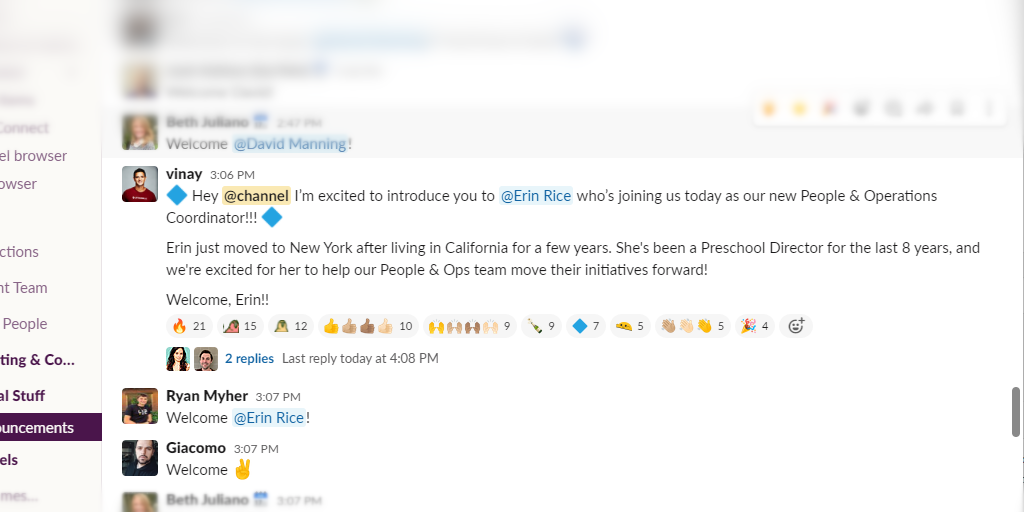 So introduce them. And don’t do that very generic, “Oh, this is Herbie, one of the full-stack engineers.” That’s lame.
So introduce them. And don’t do that very generic, “Oh, this is Herbie, one of the full-stack engineers.” That’s lame.
Try: “Hey, this is Herbie. He’s great at explaining the more technical stuff, and he makes up his own cocktails, which are actually pretty good.”
Or: “Sophie does a lot of video work, and hey – isn’t that the same university you went to? What a coincidence!”
Personalize it. Everyone loves personalization.
There’s a sneaky reason for helping your new hire make work-friends, though: culture and values. Sure, you told them what the values are. They’re printed on everything. Everyone talks about the company culture. It’s great.
None of that makes culture and values happen, though. Living them every day does. Your existing employees are your company’s emissaries: They model your organization’s culture and values to every new hire, client, or collaborator they come in contact with.
Through these work relationships, new employees will see that your values aren’t just something that’s said; they’re something that’s done.
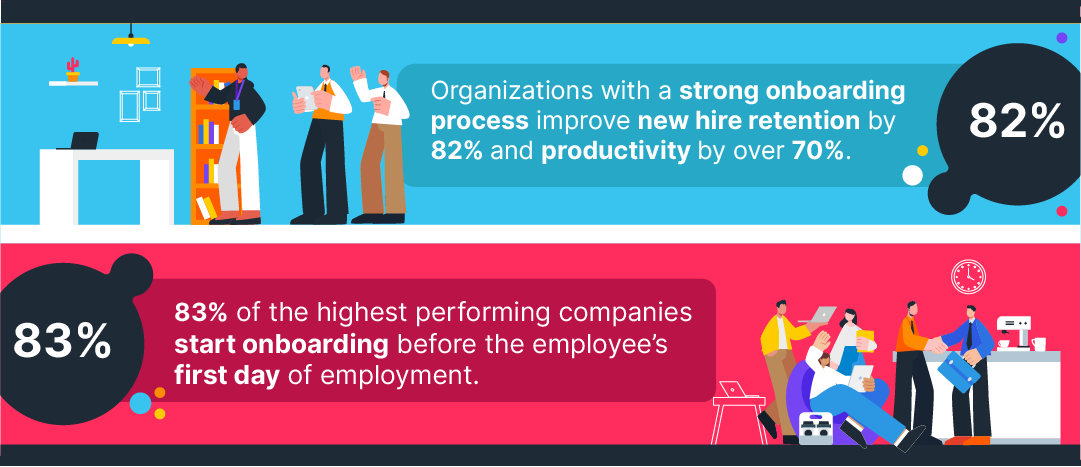
Mentorship
Time is always a thing. There’s never enough of it. No matter how much you get done in a day, it seems like that to-do list never gets any shorter.
Onboarding is not exempt from this, and time crunches can cause a huge problem with the onboarding experience. Even with a standardized structure, onboarding might be rushed through, sessions may get cut off abruptly, something unexpected might come up that needs to be handled ASAP. Stuff happens.
Using mentors or “buddies” is one way to alleviate that problem. The idea here is that the mentor/buddy will have time for their duties specifically allocated so they can provide their mentee with the time and attention they need.
The mentor isn’t overwhelmed by extra responsibilities on top of their normal workload. The employee has a designated person they can go to with any problem they have – meaning they only have to ask one person instead of five, and that one person will be able to answer promptly because they aren’t juggling a million other things.
It also establishes the very first solid relationship between the new employee and an existing one. I already mentioned how important work relationships are; a good mentor sets the tone for the new employee’s entire experience at the company.
A mentor points out the good places to sit in the cafeteria.
Repeat Continuously
Successful onboarding should last a minimum of 3-6 months, depending on your industry. In some organizations, it goes on for 2-3 years.
Whether officially or unofficially referred to as “onboarding,” the process never stops. Even an employee that’s worked for your company for 15 years will need continuous upskilling, training, and mentorship.
Regular 1:1 meetings are perfect for touching base with your employees even after the formal training period is finished. These meetings should be employee-directed and focus on the obstacles, issues, or questions they’re dealing with at the moment.
Just like in an interview: If you’re doing most of the talking, you’re doing it wrong.
Employee onboarding: Everything’s impossible until somebody does it
Click here to get the New Hire Onboarding Process Template workflow!
Conditional logic
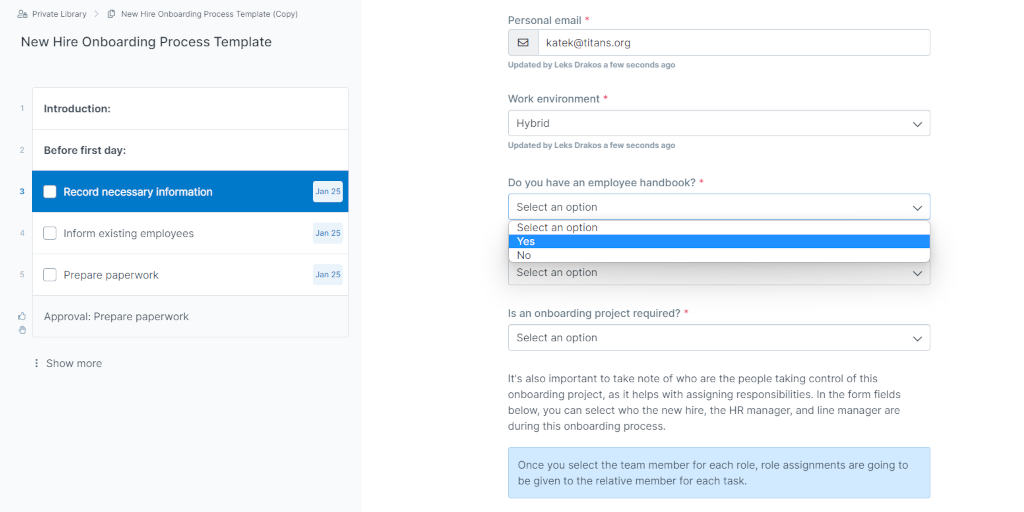 Conditional logic makes it possible for your workflows to be multi-functional.
Conditional logic makes it possible for your workflows to be multi-functional.
As you can see in the above screenshot, one of the first tasks asks if you have an employee handbook. If you select “yes” here, further down, tasks relating to the employee handbook appear.
If you don’t have a handbook – or don’t have a digital one (yet; can I recommend Pages for all your documentation needs?) – these tasks will remain hidden, so your new hire only has to handle the important stuff.
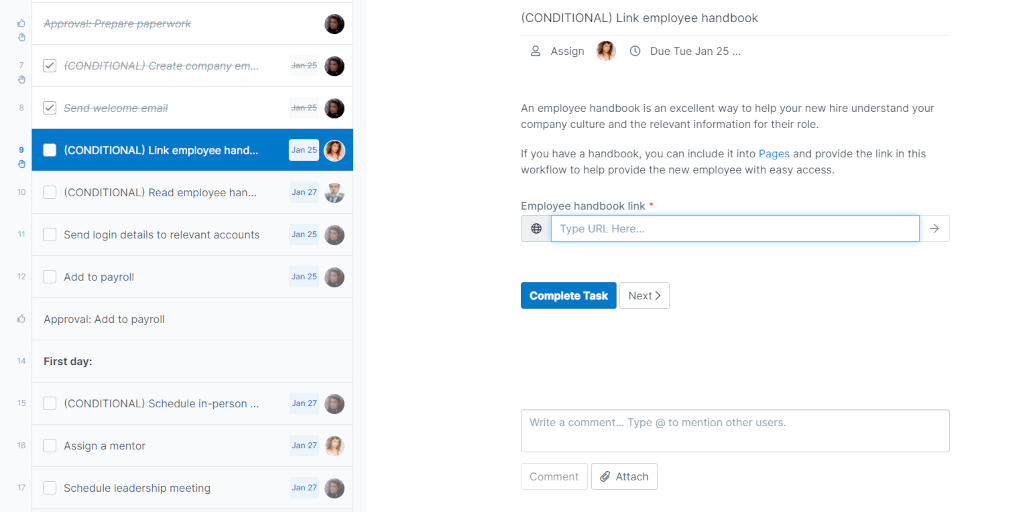 With conditional logic, you can use the same onboarding template for any department with the simplicity of a drop-down menu.
With conditional logic, you can use the same onboarding template for any department with the simplicity of a drop-down menu.
Check out how Payroll Processors has improved their client onboarding with conditional logic:
Email widget
I’m just gonna say what we all already know: Email sucks. Most of the time you just end up writing the same email over and over anyway. I know I have a collection of stock responses I use and I’m betting you do, too.
The email widget saves you the trouble. Using variables, you can pull data you’ve already entered into the workflow to a pre-written email. Once you click “send,” the email opens in your regular email client, give it a quick once-over to make sure you haven’t typed Aleks as Alex (don’t do that; x’s are so uncool), and off it goes.
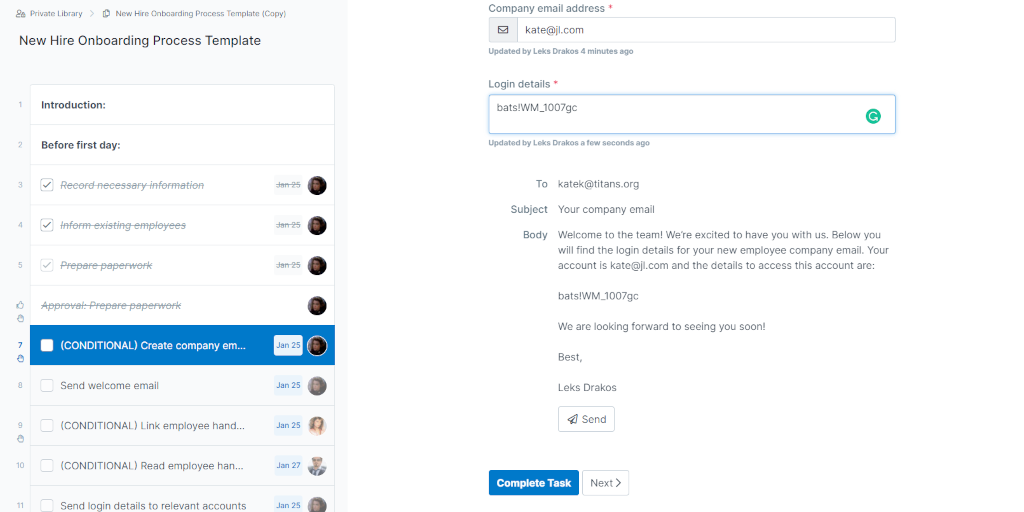 Personalized email without lifting a finger. Or without lifting multiple fingers. You’ll have to lift one to click the button.
Personalized email without lifting a finger. Or without lifting multiple fingers. You’ll have to lift one to click the button.
Approvals
Getting leadership to sign off on things – particularly these routine tasks that, yes, are important but not like, collapsing the company important. Not that your company is on the verge of collapse; just saying.
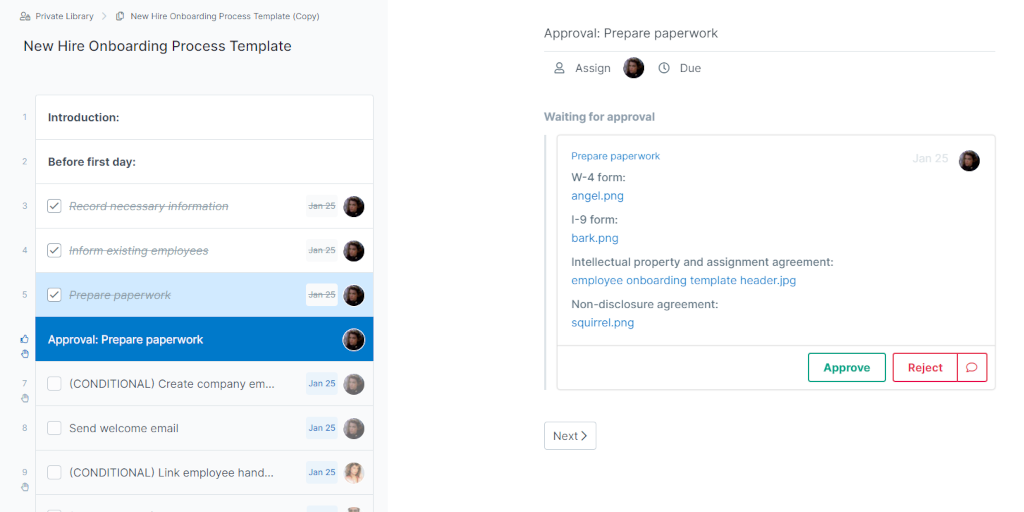 The Approvals feature solves that. Select the task(s) that need approval, and the person who needs to sign off gets a notification. Everything they need to authorize is pulled together in one central place and – yet again – at the click of a button, it’s done.
The Approvals feature solves that. Select the task(s) that need approval, and the person who needs to sign off gets a notification. Everything they need to authorize is pulled together in one central place and – yet again – at the click of a button, it’s done.
Why work harder than you have to?
Dynamic due dates
Dynamic due dates are pretty cool – and they’re another area that saves you a lot of time with automation.
I don’t get numbers. I use them every day – managing my finances, figuring out my coworkers’ time zones, scheduling meetings across those time zones – but they’re just not my thing. I guess it’s a good thing I opted for “writer” instead of “mathematician.”
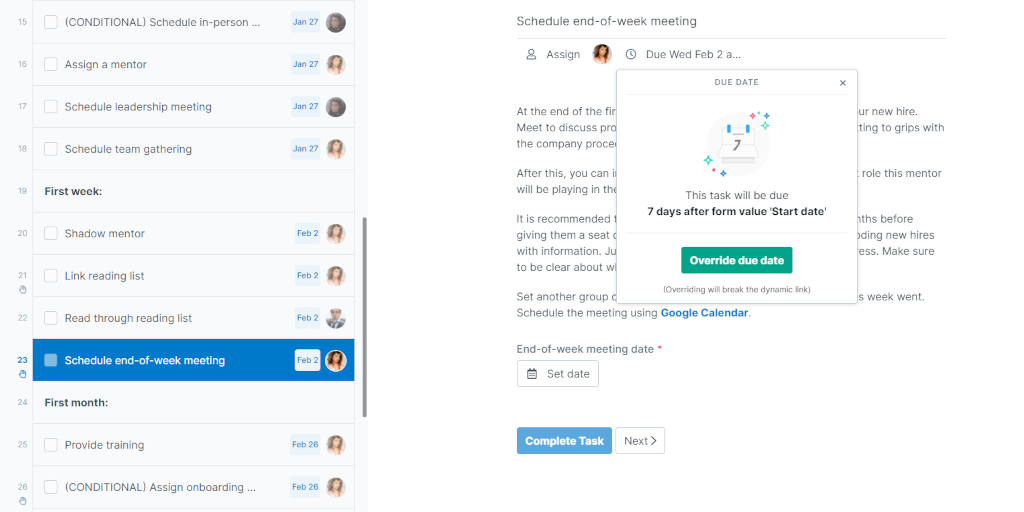 One of the tasks for the first week is to schedule an end-of-week meeting. When you reach that task, you’ll see that a due date has already been set – in this case, February 2. What is this strange and enticing magic, you ask?
One of the tasks for the first week is to schedule an end-of-week meeting. When you reach that task, you’ll see that a due date has already been set – in this case, February 2. What is this strange and enticing magic, you ask?
Dynamic due dates. The end-of-week meeting is due 7 days after the new hire’s first day. Our new hire started January 26. As soon as that was entered into the workflow, dynamic due dates calculated the date for 7 days later and – voilà! Due date set with no fiddly math on your part.
How frickin’ awesome is that?
Automations
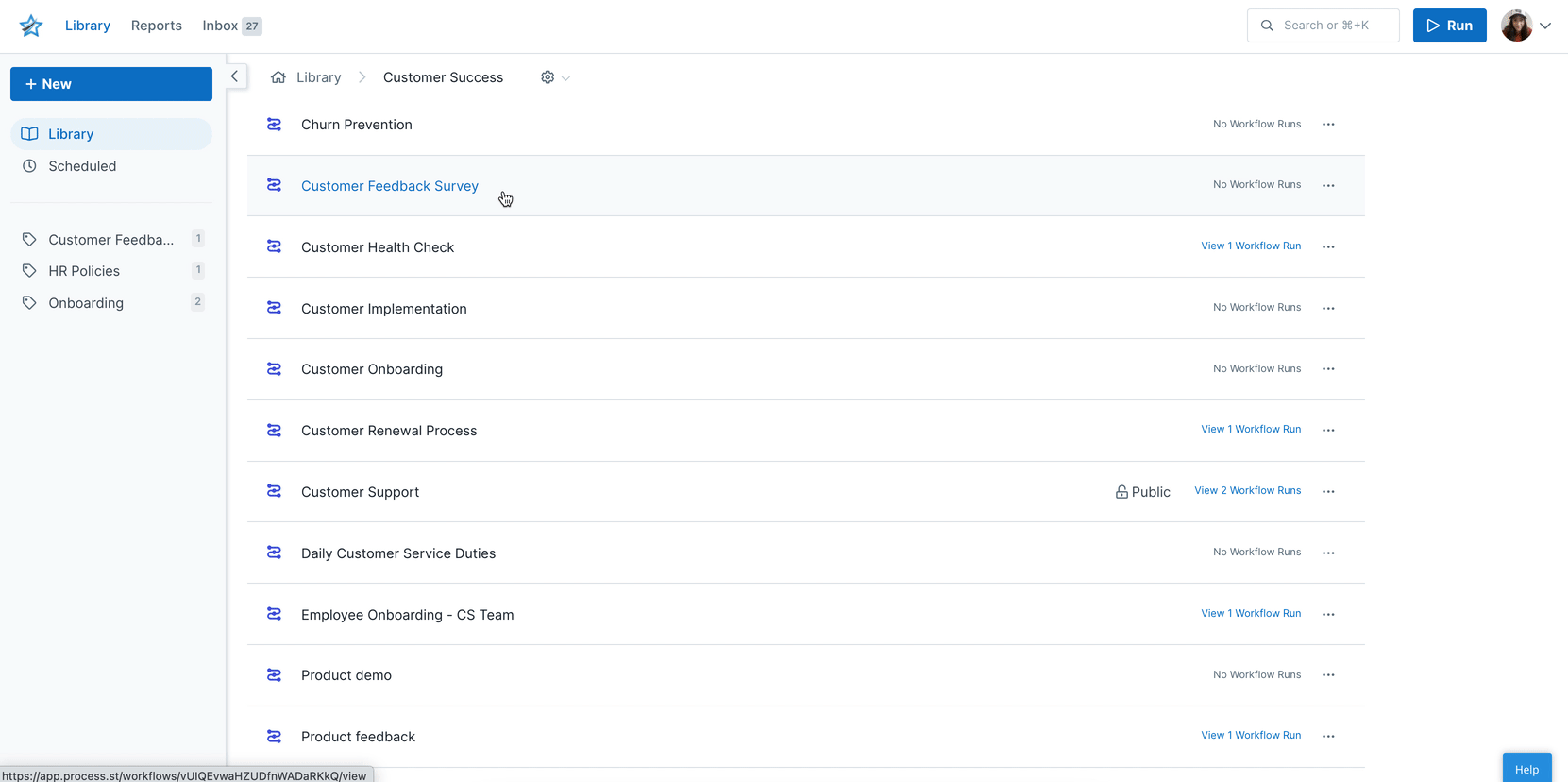 Automations is really two things, so I’m going to try really hard not to split your brain here.
Automations is really two things, so I’m going to try really hard not to split your brain here.
First, there is the Process Street Automations feature. Your day-to-day routines require a lot of different apps. So many apps.
What if you only had to use one? That’d be pretty neat, huh?
Process Street Automations combines the power of your favorite apps with the safety and control of a checklist.
With our first-party integrations, you can use Process Street to trigger actions in these apps:
- Salesforce
- Jira
- Slack
- Google Sheets
- DocuSign
- Process Street
Yep. You can integrate Process Street with Process Street. Essentially, this means that from within one workflow run, you can trigger another workflow to run when a task (or the original workflow run) is completed.
This webinar – featuring some of Process Street’s best and brightest – will load you up with everything you need to know about Process Street Automations:
What will they come up with next? Seriously, Herbie – Whatcha doin’ over there?
In addition to Automations, though, you can also automate tasks and workflows with thousands of integrations available through Zapier, Webhooks, and API integrations.
All that functionality right where you want it and no flipping through every single browser tab you have open. (Seriously, close some of those. That third one there has been open since 2002. Close it.)
For once, I’m stuck without a punchline
In the end, Bruce found his perfect fit, but along the way, he lost a number of candidates who could have been a great asset to the company. If he’d started out with a structured, documented process from the very beginning, who knows what Dick, Jason, or the others might’ve accomplished?
Equally valid, without an onboarding process, would Kate have worked out – or would she have left like all the others?
Your employees are an asset that you invest in, true. But you invest in them because of their skills and abilities. You invest in them for their ideas, their experience, their potential. If you don’t provide the foundation for them to use those attributes, you’re setting them – and your company – up to fail.
Not having a solid onboarding process just means failure before you’ve even really begun.
Watch Blake Thorne – Process Street’s product guru – explain exactly how to run a solid onboarding process in Process Street:
What’s your worst onboarding experience? What’s your best? Share your vital onboarding lessons in the comments section!







 Workflows
Workflows Forms
Forms Data Sets
Data Sets Pages
Pages Process AI
Process AI Automations
Automations Analytics
Analytics Apps
Apps Integrations
Integrations
 Property management
Property management
 Human resources
Human resources
 Customer management
Customer management
 Information technology
Information technology



Leks Drakos
Leks Drakos, Ph.D. is a rogue academic with a PhD from the University of Kent (Paris and Canterbury). Research interests include HR, DEIA, contemporary culture, post-apocalyptica, and monster studies. Twitter: @leksikality [he/him]